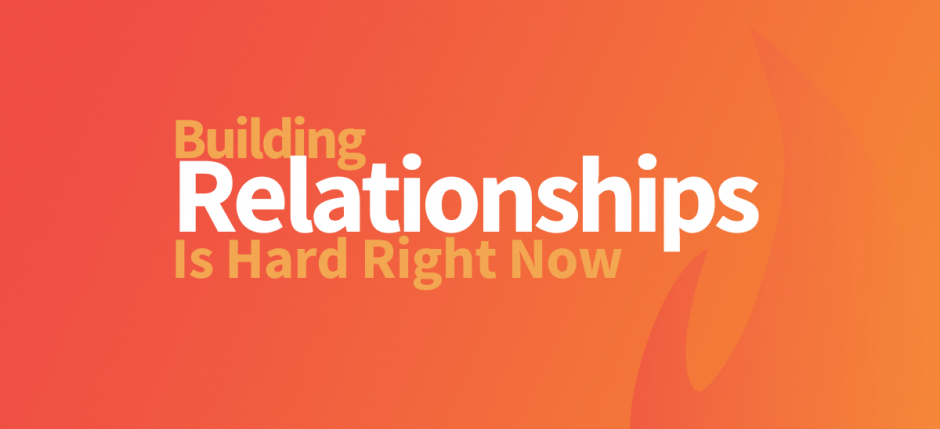Building Relationships Is Hard Right Now
by Matt Mattson
Human connection is hard right now. Building relationships is hard right now. Meeting new people is hard right now.
Here are just 10 of the many, many reasons why it’s hard…
- Quarantining
- Zoom Fatigue
- Face Masks
- 6 Feet Apart
- No Handshakes
- No Hugs
- No Big Events
- Minimal Group Gathering
- Overt Racism
- Election Year Tension
Good luck making new connections! Yikes.
[Deep Breath]
O.K., I suppose we could get mired in the swampy emotional muck that is 2020, or we could focus on WHAT IS IN OUR CONTROL. I want to offer 6 practical ways you can connect with other humans that are all entirely within your control. You might apply these in virtual meetings, in recruitment or a virtual membership intake process, in socially distanced small gatherings, in brotherhood, sisterhood, and siblinghood building efforts, in virtual classroom spaces, on social media, with your professors, with your family, in masked encounters walking through campus, and more.
6 Practical Ways To Connect With Humans in a Post COVID-19 World
1. BE EXTRA
I’m not sure how else to say this first and most important tip. We have to increase the level of HUMAN we’re being in any given moment because everything else around us is starting to feel inhuman and digital and a little scary. We have to be… a little extra.
Take Zoom (or whatever video call platform you use) for example. You know the people who don’t try very hard. They never turn on their camera… or when they do the background is a mess, the lighting is like a scene out of a vampire movie, they always forget to unmute, and you can only see the top of their head (along with a rapidly spinning ceiling fan). Don’t get me wrong… you do NOT need to impress people with fancy stuff in your background. And you can use the virtual background if needed. This isn’t about impressing people, it’s about connecting with people.
For some people right now, you ONLY exist in an occassional box inside their computer screen. Fill it with all of you. Make the little choices to be be extra in your virtual presence.
You are now the star of a TV show every day whether you like it or not. Frame yourself. Fill up the Zoom box with your head nearly touching the top, change your lighting set up, sit up, and… smile. Engage actively in the chat feature (to the whole group and through private messages to others), exaggerate your non-verbals a little, use more hand gestures… you get it. Be extra.
Oh, and when you’re in real life, face-to-face, you’ll probably be wearing a mask and standing six feet apart. You still have a “box” to fill. It’s the box that makes up the six-ish feet of space between you and the other person. Fill it with all of you. You’ll likely have to be more expressive with your eyes and your hand gestures. You’ll need to talk more loudly. You’ll need to be extra intentional and extra forgiving. In-person or online… you’ll need to be extra.
2. THE IN-BETWEEN
There are SOME moments of significant human connection right now (albeit far fewer than we’d all like). There are some altered events that are taking place. There are the Zoom meetings. There are some small gatherings. But because a) there are fewer of those things, and b) those moments are filled with other obstacles (masks, distancing, fear, etc.), it is more important now than it has ever been to maximize THE IN-BETWEEN TIME.
The in-between time is the space between the big moments. Before and after an event or virtual meeting for example… Sending personal text messages or DMs via social media. Connecting, following, liking, and commenting on social media accounts and posts. Picking up the phone for extra personal calls. Preparing questions and thoughts prior to a meeting and following up with a summary email or a thank you text. The in-between time is where real networking happens. This is where you can make small choices to deepen connection and experience a richer level of humanity in your relationships.
*Note: Be sure to intentionally schedule in-between time.
3. DIVE DEEPER
Have you noticed so many of your conversations start (and end) like this?
“So, how are you doing through all this?”
“Phew. It’s been hard. But I guess it’s been hard for everyone. I’m doing o.k. I suppose. How about you?”
“Agree. What a wild time. I just want things to go back to normal. I’m doing fine.”
Nobody is building connection in a conversation like this. It almost feels like the required way to start any interaction (but it’s not required at all). We have to dive deeper. Lead your conversations with better questions and you’ll end up with better conversations. Here are some that might work for this moment.
- What has been the best moment for you during these last few months?
- How have all the changes happening in the world impacted you most?
- How are you building connections and friendships through all of this?
- I know a lot has changed, but what are you looking forward to right now?
- I know a lot of people are worried they’re missing out on “normal” right now.. what do you want to make sure you don’t miss out on?
Great questions lead to great conversations. These are just a handful of better questions. I’m sure you can come up with your top 10 list of questions that lead to real, meaningful conversations.
4. CREATE THE CULTURE YOU CRAVE
This mantra has become incredibly important in my life. “Create the culture you crave.”
Culture and community are created by choices, and the choices you make regarding the way you interact with people contribute siginificantly to the culture within which you exist. So, create the culture you crave.
It can feel like the world is happening to us right now. A lot feels outside of our control. But we are almost entirely in control of the way we choose to interact with others, and those social choices greatly define who we are as a person.
Stop for a moment and reflect on this question, “What is the culture you crave?” (For your organization, your workplace, your school, your family, your home, your next Zoom meeting, your social media feed). You actually have a lot of influence over that culture. And if you’re a leader of any sort, one of the most powerful things you can do right now is work with your team to clearly define the CULTURE within which you want to lead. What are the expectations for how your people will interact with each other right now? What are the non-negotiables? The choices you make about the little things right now, will give you far more control over the experience you’re having.
5. REVERSE THE FRIEND FLOW
New friendships and meaningful connections are likely to have a reversed “flow” in a virtual world. Here’s what we’ve been observing.
In a pre-COVID world, one might bump into a stranger and engage in very light small talk… sports, weather, etc. The interaction would start very with very informal chit chat and small talk, and it might grow from there into more and more intimate and serious subjects of conversation. But many interactions in a virtual space start with a higher level of formality or purpose to them, and then (eventually) move into more informal topics.
So, for example, instead of finding Tanya in line at Starbucks and striking up a polite conversation about how hot/cold/rainy/snowy it is outside which leads to a comment about the changing environment, which turns into an invitation for Tanya to sit with you at a table and talk through an organization you’re involved with around environmental advocacy, which results in a deep connection around an important topic and Tanya expressing interst in joining your group…
A post-COVID converation might look like you delivering a Zoom presentation about environmental advocacy and afterwards Tanya hangs around to ask a few extra questions. After the topical questions have been finished, Tanya compliments your outfit at which point you excitedly share about the new on-line store you bought it from and how you saw it on an Instagram ad. Then Tanya jokes about how Instagram knows so much about her and how she’s a sucker for ads too, and you both feel a friendship-level connection such that the next time you encounter each other you make jokes about Instagram and compliment each other’s outfits with glee.
The flow is becoming more often reversed. And that’s o.k. It’s different, but it’s o.k.
6. REPURPOSE THE FUNDAMENTALS
Finally, remember that humans are an incredibly adaptable species. We’ve survived (as a species) plagues and pandemics before. Our social worlds have been upended an infinite amount of times, and we’ve adapted. The discovery of fire, the wheel, the printing press, the telegraph, the telephone, the internet are just a handful of the ways our social lives have been absolutely transformed over the years… and we’ve been just fine.
The secret of humans adapting to all those changes of the past? Fundamental human connection principles.
Humans connect through curiosity. When we ask each other, when we wonder together, when we inquire and research and ponder and swim in uncertainty together. We connect.
Humans connect through generosity. When we give to each other, when we are selfless, when we offer the gift of listening, when we help and support and uplift and share. We connect.
Humans connect through authenticity. When we are real with each other, when we stop trying to impress, when we are open and honest and true and pure. We connect.
Humans connect through vulnerability. When we reveal our hopes, our fears, our joins, and our sorrows, when we express real emotion, when we allow others to experience our humanity alongside us so that we might experience theirs. We connect.
Human connection is hard right now. But it is more important than ever. We must choose, in every moment, to be social… to be Socially Excellent.

